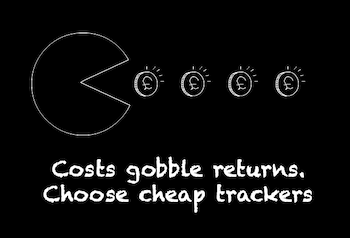This updated list of low-cost index funds and Exchange Trade Funds (ETFs) will help you to find the cheapest index trackers available in the UK.
Pick from these funds to build a diversified portfolio that – as part of a passive investing strategy – will enable you to achieve your investing goals.
Keeping charges low is a core tenet of wise investing, and so our selections are largely determined by cost and value. Every pound you save in fees is a pound that instead snowballs in your portfolio over the years.
Our piece on management fees explains how even small savings will add up to a big difference.
The growing recognition of the importance of investment fees has hugely boosted the popularity of low-cost index funds and ETFs over the past 20 years.
We too believe that these fund types are the best value investment vehicles on offer in the UK, and the right choice for passive investors.
Low-cost index funds UK – the Total Cost of Ownership
Our cheapest tracker fund UK list is divvied up into the key sub-asset classes you may wish to invest in.
The picks per asset class are ranked by their Total Cost of Ownership (TCO).
This TCO is the sum of a fund’s transaction costs and its Ongoing Charge Figure (OCF).
Many outlets only highlight a fund’s OCF (or Total Expense Ratio). But that misses out a significant chunk of cost that is captured by the less well-known transaction cost figure.
Transaction costs are the fees and taxes that all investment funds inevitably incur when trading their underlying assets.
We think it’s important to include transaction costs when considering your shortlist because such charges can be of similar size to the OCF in some sub-asset classes.
Note: fund costs are a complex and confusing area. We’ve added a few more notes about fees after the main list below.
Note II: we’ve also included the cheapest ESG option for each asset class.
Alright, let’s go hunting for bargains!
Global equity – developed world and emerging markets (All-World)
Cheapest
- Amundi Prime All Country World ETF (PACW) TCO 0.07% (OCF 0.07%, Transaction 0%)
Next best
- SPDR MSCI ACWI ETF (ACWI) TCO 0.12% (OCF 0.12%, Transaction 0%)
- HSBC FTSE All-World Index Fund C (GB00BMJJJF91) TCO 0.15% (OCF 0.13%, Transaction 0.02%)
- Invesco FTSE All-World ETF (FWRG) TCO 0.17% (OCF 0.15%, Transaction 0.02%)
- Scalable MSCI AC World Xtrackers ETF (SCXW) TCO 0.18% (OCF 0.17%, Transaction 0.01%)
- SPDR MSCI ACWI IMI ETF (IMID) TCO 0.18% (OCF 0.17%, Transaction 0.01%)
- SPDR MSCI ACWI Climate Paris Aligned ETF (SAPA) TCO 0.22% (OCF 0.2%, Transaction 0.02%)
World equity – developed world only
Cheapest
- Amundi Prime Global ETF (MWOZ) TCO 0.05% (OCF 0.05%, Transaction 0%)
Next best
- UBS Core MSCI World ETF (WRDA) TCO 0.06% (OCF 0.06%, Transaction 0%)
- Franklin FTSE Developed World ETF (DWLD) TCO 0.11% (OCF 0.09%, Transaction 0.02%)
- iShares Developed World Index Fund D (IE00BD0NCL49) TCO 0.12% (OCF 0.12%, Transaction 0%)
- iShares Developed World Fossil Fuel Screened Index Fund (GB00BFK3MT61) TCO 0.12% (OCF 0.11%, Transaction 0.01%)
World ex-US equity
Cheapest
- iShares MSCI World ex-USA ETF (XUSE) TCO 0.15% (OCF 0.15%, Transaction 0%)
Next best
- Amundi MSCI World ex-USA ETF (WEXU) TCO 0.16% (OCF 0.15%, Transaction 0.01%)
- Xtrackers MSCI World ex-USA ETF (XMWX) TCO 0.17% (OCF 0.15%, Transaction 0.02%)
World ex-UK equity
Cheapest
- Vanguard FTSE Dev World ex-UK Equity Index Fund (GB00B59G4Q73) TCO 0.16% (OCF 0.14%, Transaction 0.02%)
Next best
- L&G International Index Trust I Fund (GB00B2Q6HW61) TCO 0.16% (OCF 0.13%, Transaction 0.03%)
- Aviva Investors International Index Tracking SC2 Fund (GB00B2NRNX53) TCO 0.25% (OCF 0.25%, Transaction 0%)
You can also pick ‘n’ mix using individual US, Europe ex-UK, Japan, and Pacific ex-Japan trackers.
World income equity
Cheapest
- Xtrackers MSCI World High Dividend Yield ESG ETF (XZDW) TCO 0.29% (OCF 0.25%, Transaction 0.04%)
Next best
- Vanguard FTSE All-World High Dividend Yield ETF (VHYG) TCO 0.32% (OCF 0.29%, Transaction 0.03%)
- iShares World Equity High Income Active ETF (WINC) TCO 0.35% (OCF 0.35%, Transaction 0%)
- UBS S&P Dividend Aristocrats ESG Elite ETF (UBUM) TCO 0.35% (OCF 0.3%, Transaction 0.05%)
- Franklin Global Quality Dividend ETF (FLXX) TCO 0.36% (OCF 0.3%, Transaction 0.06%)
- Vanguard Global Equity Income Fund (GB00BZ82ZW98) TCO 0.67% (OCF 0.48%, Transaction 0.19%)
The Vanguard fund is active but gives you a non-ETF option.
World small cap equity
Cheapest
- UBS MSCI World Small Cap Socially Responsible ETF (WSCR) TCO 0.24% (OCF 0.23%, Transaction 0.01%)
Next best
- HSBC MSCI World Small Cap Screened ETF (HWSS) TCO 0.27% (OCF 0.25%, Transaction 0.02%)
- iShares MSCI World Small Cap ETF (WLDS) TCO 0.36% (OCF 0.35%, Transaction 0.01%)
- Vanguard Global Small-Cap Index Fund (IE00B3X1NT05) TCO 0.38% (OCF 0.29%, Transaction 0.09%)
- Avantis Global Small Cap Value ETF (AVSG) TCO 0.48% (OCF 0.39%, Transaction 0.09%)
The Avantis ETF is specifically small cap value, not just small cap.
US large cap equity
Cheapest
- SPDR S&P 500 ETF (SPXL) TCO 0.03% (OCF 0.03%, Transaction 0%)
- Amundi MSCI USA ETF (MSCU) TCO 0.03% (OCF 0.03%, Transaction 0%)
- UBS Core S&P 500 ETF (S5UA) TCO 0.03% (OCF 0.03%, Transaction 0%)
Next best
- iShares US Equity Index Fund D (GB00B5VRGY09) TCO 0.06% (OCF 0.05%, Transaction 0%)
- HSBC American Index Fund C (GB00B80QG615) TCO 0.06% (OCF 0.06%, Transaction 0%)
- Fidelity Index US Fund P (GB00BJS8SH10) TCO 0.06% (OCF 0.06%, Transaction 0%)
- Amundi S&P 500 Climate Paris Aligned ETF (CLMT) TCO 0.08% (OCF 0.07%, Transaction 0.01%)
The tax treatment of US equities gives synthetic ETFs a tax advantage over physical funds. Find out more in our Best S&P500 ETFs and index funds article.
UK large cap equity
Cheapest
- iShares UK Equity Index Fund D (GB00B7C44X99) TCO 0.05% (OCF 0.05%, Transaction 0%)
Next best
- abrdn UK All Share Tracker Fund B (GB00B76B9Y24) TCO 0.06% (OCF 0.05%, Transaction 0.01%)
- Fidelity Index UK Fund P (GB00BJS8SF95) TCO 0.09% (OCF 0.06%, Transaction 0.03%)
- HSBC FTSE All Share Index Fund Institutional (GB0030334345) TCO 0.1% (OCF 0.03%, Transaction 0.07%)
- Vanguard FTSE UK All Share Index Unit Trust (GB00B3X7QG63) TCO 0.11% (OCF 0.06%, Transaction 0.05%)
- L&G UK Equity ETF (LGUK) TCO 0.13% (OCF 0.05%, Transaction 0.8%)
- iShares UK Equity ESG Screened and Optimised Index Fund D (GB00BN08ZV03) TCO 0.19% (OCF 0.05%, Transaction 0.14%)
Emerging markets equity
Cheapest
- Amundi MSCI Emerging Markets ETF (LEMA) TCO 0.14% (OCF 0.14%, Transaction 0%)
Next best
- Franklin FTSE Emerging Markets ETF (EMER) TCO 0.15% (OCF 0.11%, Transaction 0.04%))
- HSBC MSCI Emerging Markets ETF (HMEC) TCO 0.17% (OCF 0.15%, Transaction 0.02%)
- iShares Emerging Markets Index Fund D (GB00B84DY642) TCO 0.19% (OCF 0.19%, Transaction 0%)
- iShares Emerging Markets Equity ESG Screened and Optimised Index Fund D (GB00BN090307) TCO 0.21% (OCF 0.19%, Transaction 0.02%)
Property – global
Cheapest
- Xtrackers Developed Green Real Estate ESG ETF (XDRE) TCO 0.23% (OCF 0.18%, Transaction 0.05%)
Next best
- L&G Global Real Estate Dividend Index Fund I (GB00BYW7CN38) TCO 0.25% (OCF 0.21%, Transaction 0.04%)
- HSBC ETF FTSE EPRA/NAREIT Developed ETF (HPRS) TCO 0.26% (OCF 0.24%, Transaction 0.02%)
- VanEck Global Real Estate ETF (TREG) TCO 0.26% (OCF 0.25%, Transaction 0.01%)
- Amundi ETF FTSE EPRA/NAREIT Global ETF (EPRA) TCO 0.27% (OCF 0.24%, Transaction 0.03%)
Multi-factor – global
Cheapest
- JPMorgan Global Equity Multi-Factor ETF (JPLG) TCO 0.21% (OCF 0.19%, Transaction 0.02%)
Next best
- Invesco Global ex UK Enhanced Index Fund Z (GB00BZ8GWT74) TCO 0.28% (OCF 0.23%, Transaction 0.05%)
- iShares STOXX World Equity Multifactor ETF (FSWD) TCO 0.37% (OCF 0.3%, Transaction 0.07%)
- Invesco Quantitative Strategies ESG Global Equity Multi-Factor ETF (IQSA) TCO 0.39% (OCF 0.3%, Transaction 0.09%)
- HSBC Multi-Factor Worldwide Equity ETF (HWWA) TCO 0.39% (OCF 0.25%, Transaction 0.14%)
Factor investing strays into active management territory. You are hoping your chosen subset of the market will outperform. Select funds underpinned by sound financial theory, a verifiable set of rules, and a commitment to low costs.
Regional factor ETFs are available. But we’ve stuck to global multi-factor low-cost index funds for broad diversification.
Money market – GBP
Cheapest
- Lyxor Smart Overnight Return ETF (CSH2) TCO 0.1% (OCF 0.1%, Transaction 0%)
- Royal London Short Term Money Market fund (GB00B8XYYQ86) TCO 0.1% (OCF 0.1%, Transaction 0%)
- Xtrackers GBP Overnight Rate Swap ETF (XSTR) TCO 0.1% (OCF 0.1%, Transaction 0%)
- UBS GBP Overnight Rate SF ETF (GBPO) TCO 0.1% (OCF 0.1%, Transaction 0%)
Money market funds are actively managed.
UK Government bonds – intermediate
Cheapest
- Amundi UK Government Bond ETF (GILS) TCO 0.06% (OCF 0.05%, Transaction 0.01%)
- Invesco UK Gilts ETF (GLTA) TCO 0.06% (OCF 0.06%, Transaction 0%)
Next best
- iShares Core UK Gilts ETF (IGLT) TCO 0.09% (OCF 0.07%, Transaction 0.02%)
- Fidelity Index UK Gilt Fund P (GB00BMQ57G79) TCO 0.1% (OCF 0.1%, Transaction 0%)
- iShares GiltTrak Index Fund (IE00BD0NC250) TCO 0.1% (OCF 0.1%, Transaction 0%)
UK Government bonds – long
Cheapest
- iShares Over 15 Years Gilts Index Fund (GB00BF338G29) TCO 0.11% (OCF 0.11%, Transaction 0%)
Next best
- Vanguard UK Long-Duration Gilt Index Fund (GB00B4M89245) TCO 0.12% (OCF 0.12%, Transaction 0%)
- SPDR Bloomberg Barclays 15+ Year Gilt ETF (GLTL) TCO 0.15% (OCF 0.15%, Transaction 0%)
UK Government bonds – short
Cheapest
- L&G UK Gilt 0-5 Year ETF (UKG5) TCO 0.07% (OCF 0.06%, Transaction 0.01%)
- Invesco UK Gilt 1-5 Year ETF (GLT5) TCO 0.07% (OCF 0.06%, Transaction 0.01%)
- Amundi UK Government Bond 0-5Y ETF (GIL5) TCO 0.07% (OCF 0.05%, Transaction 0.02%)
Next best
- Goldman Sachs Access UK Gilts 1-10 Years ETF (GBPG) TCO 0.09% (OCF 0.07%, Transaction 0.02%)
- iShares Up to 10 Years Gilts Index Fund (GB00BN091C65) TCO 0.14% (OCF 0.13%, Transaction 0.01%)
The 1-10 years funds have a longer bond duration than the other short-dated funds in this section, but are significantly shorter duration than standard UK all-stocks or intermediate funds.
UK Government bonds – index-linked
Cheapest
- Amundi UK Government Inflation-Linked Bond ETF (GILI) TCO 0.07% (OCF 0.07%, Transaction 0%)
Next best
- L&G All Stocks Index Linked Gilt Index Trust C (GB00BG0QNY41) TCO 0.08% (OCF 0.08%, Transaction 0%)
- iShares Up to 10 Years Index Linked Gilt Index Fund D (GB00BN091H11) TCO 0.13% (OCF 0.13%, Transaction 0%)
UK index-linked funds may not be suitable for your portfolio due to embedded real interest risk. In our Slow and Steady portfolio we’ve switched to a short duration global index-linked fund, hedged to GBP. For those, see below.
The iShares Up to 10 Years Index Linked Gilt Index Fund is relatively new. But we think it’s the best inflation-hedge from the selection above as it’s the shortest duration GBP linker fund available.
Global inflation-linked bonds hedged to £ – short
Cheapest
- Abrdn Short Dated Global Inflation-Linked Bond Tracker Fund B (GB00BGMK1733) TCO 0.14% (OCF 0.14%, Transaction 0%)
Next best
- Amundi Global Inflation-Linked 1-10Y Bond ETF (GISG) TCO 0.2% (OCF 0.2%, Transaction 0%)
- Royal London Short Duration Global Index Linked Fund M (GB00BD050F05) TCO 0.27% (OCF 0.27%, Transaction 0%)
The Royal London fund is actively managed.
Global government bonds hedged to £
Cheapest
- Amundi Prime Global Government Bond ETF (PRHG) TCO 0.09% (OCF 0.07%, Transaction 0.02%)
Next best
- Abrdn Global Government Bond Tracker Fund B (GB00BK80KQ76) TCO 0.13% (OCF 0.13%, Transaction 0%)
- iShares Broad Global Government Bond ETF (IGBS) TCO 0.13% (OCF 0.13%, Transaction 0%)
- Amundi Index JP Morgan GBI Global Govies ETF (GOVG) TCO 0.16% (OCF 0.15%, Transaction 0.01%)
- iShares Overseas Government Bond Index Fund D (GB00BN091P94) TCO 0.18% (OCF 0.13%, Transaction 0.05%)
Gold
Cheapest
- Amundi Physical Gold ETC (GLDA) TCO 0.12% (OCF 0.12%, Transaction 0%)
- Invesco Physical Gold A ETC (SGLP) TCO 0.12% (OCF 0.12%, Transaction 0%)
- WisdomTree Core Physical Gold ETC (GLDW) TCO 0.12% (OCF 0.12%, Transaction 0%)
- Xtrackers IE Physical Gold ETC (XGDU) TCO 0.12% (OCF 0.12%, Transaction 0%)
- iShares Physical Gold ETC (SGLN) TCO 0.12% (OCF 0.12%, Transaction 0%)
Gold trackers are Exchange Traded Commodities (ETCs). These are functionally index trackers like ETFs, only they’re focused on commodities investing.
Broad commodities
Cheapest
- Xtrackers Bloomberg Commodity Swap ETF (XCMC) TCO 0.19% (OCF 0.19%, Transaction 0%)
Next best
- iShares Diversified Commodity Swap ETF (COMM) TCO 0.29% (OCF 0.19%, Transaction 0.1%)
- WisdomTree Broad Commodities ETF (COMX) TCO 0.29% (OCF 0.29%, Transaction 0%)
- UBS CMCI Composite SF ETF (UC15) TCO 0.34% (OCF 0.34%, Transaction 0%)
- Invesco Bloomberg Commodity ETF (CMOP) TCO 0.34% (OCF 0.19%, Transaction 0.15%)
- L&G Longer Dated All Commodities ETF (CMFP) TCO 0.73% (OCF 0.3%, Transaction 0.43%)
We’ve written a much more nuanced take on choosing a commodities ETF. Sometimes cheapest isn’t best.
Using our cheapest index funds UK list
You can precisely identify the low-cost index funds you want to research via the ISIN codes or ETF tickers shown in our list in brackets. (We’ve previously explained how fund names work.)
We’ve given the code for the GBP-priced accumulation fund flavour where available. Income distributing versions are also usually offered. Make sure you understand the ins and outs of accumulation vs income funds.
Also note:
- We’ve included an Environmental, Social, and Governance (ESG) index tracker option for each sub asset-class where available.
- Actively-managed funds are featured when low-cost index funds are not available. Active funds are noted in the relevant sections.
- We don’t show platform-exclusive index trackers. They’re generally not a good deal overall.
Cheap index trackers and costs – extra detail
The bid-offer spread is an additional cost you may incur that isn’t captured by the TCO figures quoted above.
This charge shouldn’t be significant for most passive investors anyway but you can gauge it by using the estimated spread published by Hargreaves Lansdown on its fund pages.
The final significant investing cost you’ll need to pay are broker fees. We track those on our broker comparison table.
Watch out for FX fees charged by brokers on certain funds. This is a stealth cost that you can avoid.
Some providers of synthetic ETFs publish a ‘swap fee’ on top of the TER. Just add the swap fee to the TER to get the Ongoing Charge Figure. This is how we’ve treated swap fees in the listing above.
It’s worth knowing that a fund’s transaction costs can fluctuate quite a lot from period to period, especially if there’s excessive turnover in the fund’s index. So don’t feel like you need to instantly switch if your fund’s transaction costs suddenly spike. Keep your fund and its main rivals under review for up to a year before coming to any definitive conclusion about its competitiveness.
Some index trackers register negative transaction costs, but I’ve disregarded that from the TCO calculations above. That’s because negative transaction costs amount to an accounting technique that’s not sustainable over time.
Low-cost index funds UK – fees you can ignore
Don’t pay any attention to a fund’s Annual Management Charge (AMC). The AMC is an old-fashioned fee metric that excludes important fund costs. This is why a fund’s AMC is typically lower than its OCF or TER.
Do not add the AMC to the OCF or TER.
The OCF and TER are interchangeable, however, so choose one of those costs (the highest) and add it to the fund’s transaction cost to calculate its TCO.
Treat negative transaction costs as zero.
Ignore entry and exit charges for index trackers where you see them mentioned in fund literature such as Key Investor Information Documents. Such fees do not apply to ordinary investors like you and me. They are levied on institutional participants dealing directly with the fund provider.
The same thing goes if you see an eye-watering minimum purchase figure (such as £100,000) to buy into a fund.
Be guided by your broker’s minimum purchase amount.
Final thoughts on low-cost index funds and ETFs
There’s often little to distinguish index trackers that are closely matched in price. However we’ve written a few pieces to help you resolve tie-breaker situations:
If you’re looking for the cheapest place to buy and hold your low-cost index funds then also take a gander at our broker comparison table.
Our article on designing your own asset allocation will help you to construct your portfolio. If you want a shortcut, you could do a lot worse than check out our best multi-asset fund picks for an instant portfolio solution.
We periodically update this list of low-cost funds. Quoted TCOs may date as fund groups fight their turf wars by undercutting each other (hurrah!) but this article should still be an excellent starting point for your research.
If anyone comes across any better index tracker options then please let us know in the comments below.
Take it steady,
The Accumulator
Note: early comments below may refer to an older collection of low-cost index trackers. Scroll down for the latest thoughts.




